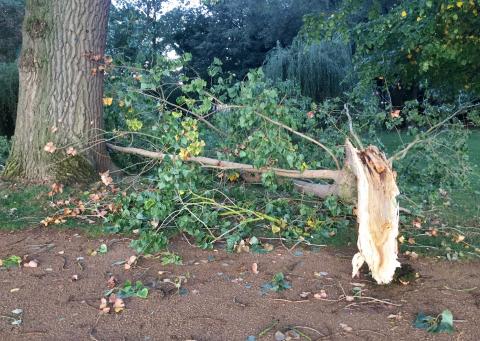Breadcrumb
Branching off: new trees for New Walk
Our Gardens Team has taken the difficult step of removing a number of Black Poplar trees that have stood in Christ Church's New Walk for nearly a century, replacing them with Common Limes. Our Head Gardener John James explains why, and tells us about how the ambitious project has progressed.
Back in 2015, following agreement with the Oxford City tree officers, Forestry England, English Heritage, the Oxfordshire Gardens Trust and the Oxfordshire Preservation Society, we began a phased removal of the over-mature Hybrid Black Poplars (Populus x canadensis) from New Walk. Consultation with so many parties was important due to the fact that the Meadow is listed as a Grade 1 Historic Park and Garden and is within the Oxford Central (University and City) Conservation Area. Forestry England has to be included in any such discussions if the volume of timber to be felled exceeds ten cubic meters per calendar quarter.
New Walk was originally planted in the 1860s when the Meadow Building was built, to encourage people to walk from the entrance down towards the river. We do not know what the original trees were, but since none survive from that time, it is likely that they were elms, which were then lost to Dutch Elm disease. Today the avenue consists of a mixture of Hybrid Black Poplars, Balsam Poplars and a number of lime tree (Tilia) species.

These Hybrid Black Poplars were planted in the 1920s, making them almost 100 years old. Sadly, poplars do not age well and these had begun to suffer from decay, dropping large branches with no warning and in apparently favourable conditions. Because of the danger to Meadow visitors it became clear that the trees needed to be replaced. Although it is sad to lose such large trees, they had become unsafe, and actually did not make a very positive impact on the landscape, being quite ungainly in character and supporting very little in the way of wildlife.

Together with historic tree avenue specialist Sarah Couch, we came up with a plan for the phased removal of the trees over nearly ten years. This phased approach meant that there would be less visual impact on the Christ Church landscape and the workload could be spread out.
Prior to this phased programme two trees were removed as they were considered as too potentially unsafe to retain, and once felled a significant amount of decay was revealed.
The first phase in 2015 involved the removal of the first ten most dangerous trees. This was followed in the winter of 2019/20 by the removal of a further six trees. Phase three, the removal of the last three trees, has just been completed.

Although no bats had been reported roosting in the trees to be felled, all trees were thoroughly inspected for bat roosts by a qualified bat consultant before any felling took place. No evidence of bat roosts was seen, but as mitigation for any possible loss of habitat, bat boxes were installed in adjacent trees.

With each phase of removal, the trees have been replaced by more suitable, historically appropriate and much longer-lived Tilia x europaea 'Pallida', the Common Lime. The clone 'Pallida' was chosen as being less liable to scrubby basal growth compared to other varieties.

21 new trees were planted in the first phase, which also included filling in some existing gaps in the avenue, six new trees in phase two, and a final four trees that have just been planted. In total, 19 trees have been removed and 33 have been planted.
For more images of our gardens and Meadow, visit John James' Instagram page, @ChristChurchGardener.
Other Christ Church news




